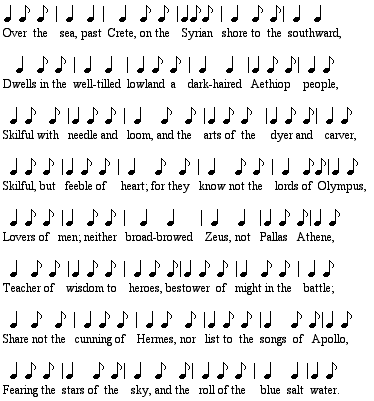
With considerable oversimplification, Parry's explanation of these repeated phrases, etc. is that this is a phenomenon characteristic of orally composed poetry. In a sense, the repeated phrases serve as an aid to oral composition, giving the singer a chance to plug in a familiar phrase while he thinks ahead to how he will compose the next line or so. Accordingly, with the use of repeated formulas, a consistently rhythmical poem can be fairly readily composed orally - and also more or less extemporaneously.
(As already mentioned in class, an interesting reconstruction of what a Homeric passage sounded like, as originally performed, is available from Georg Danek and Stefan Hagel, Homeric Singing - An Approach to the Original Performance.This includes a recitation, in an attempt at the original Greek pronunciation and musical accompaniment, of Demodokos' song about Ares and Aphrodite: Odyssey 8. 267-366. For an English translation of this passage, see H & P, pp. 162-164; H & P give the line nos. as 1-109).
 or spondee
or spondee and the last foot (or measure) is always two syllables, i.e. a spondee
and the last foot (or measure) is always two syllables, i.e. a spondee  or trochee
or trochee 
The overall pattern of a dactylic hexameter line, then, is the following:

Dactylic hexameter is not very frequently used in English, but it has occasionally been tried. Probably the best known example is Longfellow, Evangeline; however, Longfellow's poem is not very much read today. An interesting example of English dactylic hexameter is a poem by Charles Kingsley, entitled Andromeda - basically, this is the story of Perseus and Andromeda, given by H & P, p. 276. (Kingsley follows an alternative version of the story, which puts Andromeda's family - Cepheus, Cassiopeia, et al. - in the Syrian town of Joppa, rather than in Ethiopia proper; this alternative version is also followed in the film Clash of the Titans.) Kingley's poem begins as follows:

Likewise, in Greek, the beginning of the Iliad is as follows:

Note that this contains the patronymic Pêlêiadeô "son of Peleus". With an attempt at an English dactylic hexameter, one could translate the whole line as follows:

Another example of an epithet phrase is one meaning "Apollo who strikes from afar". This regularly occurs at the end of the hexameter line, as follows:

One could attempt an English translation of this into the last part of a hexameter line, as follows:

As it happens, the Fitzgerald translation of the Iliad (H & P, pp. 334-401) does not exhibit the phenomenon of Homeric repetition very clearly. (In this respect, Fitzgerald's translation is quite "free".)
On the other hand, Lattimore's translation gives a reasonably good view of this phenomenon. (Lattimore does not, however, consistently keep patronymics and epithets in the same place in the line as they are in the original.) Lattimore's translation is available online through the Chicago Homer.
In Lattimore's translation of the first 21 lines of Iliad, Book 1 ( = first 24 lines in Fitzgerald) one finds several instances of patronymics and epithet-phrases which Fitzgerald omits. The reference to Agamemnon as "son of Atreus" is omitted by Fitzgerald in his translation of what Lattimore gives as lines 11 and 17. Similarly, the epithet of Apollo is omitted in Fitzgerald's translation of what Lattimore gives as lines 15 and 21. Rouse too omits the phrase "son of Atreus" at Lattimore's lines 11 and 17. On the other hand, Rouse includes the Homeric phrase for Apollo, viz., as "Apollo Shootafar", whereas Fitzgerald simply has "the god's" and "Apollo" in these two instances.
The lines will be discussed in class in connection with quotes from the nineteenth century British critic John Ruskin (basically a "Unitarian" approach) and from Milman Parry, the founder of the Oralist approach. The quotes are available at about p. 3 of 9 at a Scandinavian website. (The quotes, however, are in English):
Also, cf. the remark of the Analytic scholar Walter Leaf, available from the Perseus project:
As will be discussed in class lectures, the first sentence on H & P, p. 323, although it makes an important point, needs to reconsidered. (The sentence runs as follows: "Omitting all mention of the Promethean prophecy, of the decision of Paris and the divine quarrel that precedes the war, and of the failed attempt of Thetis to immortalize her son, Homer centers the Iliad squarely in the human world.") H & P's concluding phrase, viz., "Homer centers the Iliad squarely in the human world," is right on the mark. Otherwise, though, their analysis is oversimplified. Actually, there is a mention of the judgment of Paris (to be discussed later in class) in Iliad, Book 24, and one could also argue that the "Promethean prophecy" and "the failed attempt of Thetis to immortalize her son" are, in some form or other, crucial in understanding the poem. The importance for the Iliad of the myths centering around Thetis is developed by Laura Slatkin in her Power of Thetis. There is an excellent review of this book by Andrew Sprague Becker in Bryn Mawr Classical Review 03.03.16.